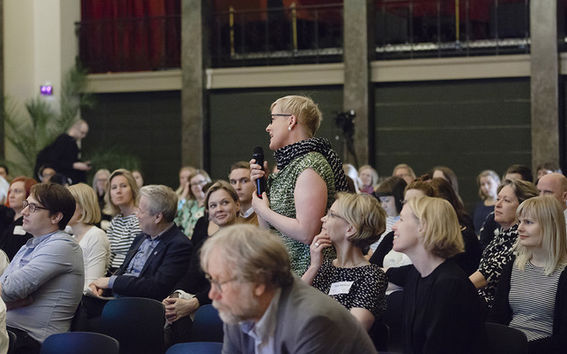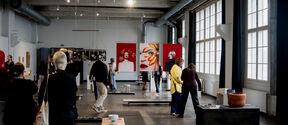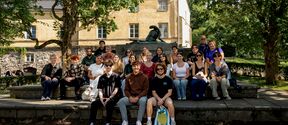Design is shaping the ministries’ future – from office to carrot fields

Is design a relevant tool for developing the working practices of future civil servants or sustainable food models of municipalities? The answer is yes, once the challenges are approached by listening to people, comprehensively, yet braking down to pieces, through trialing, involving and innovating.
This was all seen on May 23 in the White Hall of Helsinki, where the multidisciplinary student teams presented their work addressing the briefs commissioned by six ministries. Since 2013, the Aalto University School of Arts, Design and Architecture course has tackled public sector and government challenges with design methods.
Civil servant 2.0 – let’s co-operate!
Once the world around is getting more and more complex and less predictable, there is pressure for the ministries to renew their working practices.
In the project brief Civil servant 2.0: Future work of civil servants two teams were set to find out ways for increasing genuine collaboration between civil servants and ministries. The project was commissioned by the Ministry of Finance, the Ministry of Economic Affairs and Employment, the Prime Minister’s Office and the Ministry of Transport and Communications.
“While the ministry representatives opened up their working practices, it emerged that for one collaboration means having a cup of coffee with a colleague, while another sees it is as legislative co-operation between ministries”, says Yuri Fukamati, student of the Collaborative and Industrial Design Master’s Programme.
Several meetings, interviews and workshops were held during the 14 course weeks. Also, countless number of post-it notes were needed to highlight the theme of collaboration.
”It is easy to talk about collaboration needs, but only when the lack of collaboration is faced as a problem, one can start changing things”, says Fukamati.
Collaboration skills should be added to the job descriptions and work demands of the ministries. Also, for the future work of civil servants to be more agile, a training program is needed for practicing and developing the collaboration skills.
The other student team developed a KYKY-program which helps the civil servants to share knowledge of their working skills. The digital KYKY service tool encourages network building and adopting new ways of working.
Farmer’s hard work is turned into design stories
The project commissioned by the Ministry of Environment, the Ministry of Agriculture and Forestry, Motiva and Sitra dealt with a model for regional sustainable circular food.
The Food Systemantics team focused on primary food production and found itself in the farms of Forssa region.
“Farming is hard work and the subsidy bureaucracy takes a lot of the farmers’ working time. Although Finland is abundant with clean and decent soil, the farming occupation is not attractive”, says student Anna Kokki of the Creative Sustainability Master’s Programme.
There are at the moment several development projects going on related to food production. Yet something is wrong, as the projects, services and the supporting networks do not work in the desired way.
Three stories were created to demonstrate better ways for the system to communicate. Instead of generating new expenses, the team created ideas for more efficient focusing of the current subsidy systems.
“A mentoring programme would be a way for possible career-changers to get farming experience. On the other hand, entrepreneurial advisory services could help older farmers to increase their profit and raise their contribution towards pension”, says Kokki.
The biodiversity of crops could be ensured by targeting funding for alternative farming practices in small farms and for trying out new crops in large farms.
Forssa’s carrots and complex tendering process
Also, the other team travelled to the farming and carrot city Forssa to meet the public food procurers, central kitchen staff, citizens and local farmers.
”Forssa is a city with a lot of farming and food production. Still, only 4% of local farming products is used in Forssa public procurement”, says student Helén Marton of the Creative Sustainability Master’s Programme.
The benefits of locality include the freshness and nutritional values of food as well as supporting the local economy.
”Strategic guidance is needed to increase the amount of local food in public procurement.
The Public Procurement Act impedes favoring local production, but the tenders may include for example requirements for fresh food. The procurement staff needs training for supporting locality in tendering”, say Marton.
Once the farmers, local food procurers and central kitchen staff are brought together, it is easier to understand which food is locally available and which food products each farmer is able to produce.
”We also established an Innovation Lab for developing new food products and for promoting food circularity”, concludes Marton.
Read more news
Growing Materials, Growing Ideas: Inside the Biomaker Studio
At Aalto University’s Biomaker Studio, initiated by Ena Naito, students and researchers experiment with living materials, from algae to mycelium, creating an open, interdisciplinary space where design, biology, and collaboration grow together.
The year in Review: What happened in 2025?
A recap of the milestones of the Master in Contemporary Design in 2025
“This hands-on approach is the absolute best way to learn” – Loyola University and Aalto University partnered for the sixth time
Isabel Towghi shares her experience from Aalto University Summer School.






